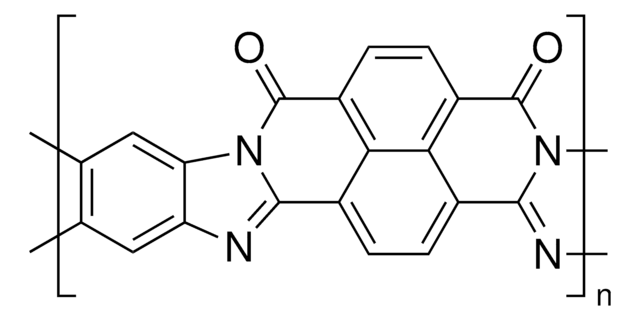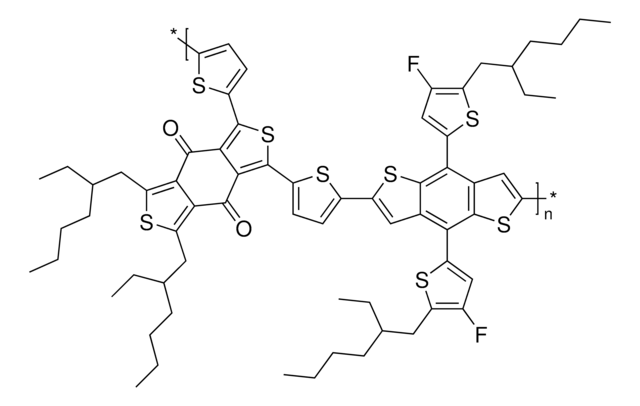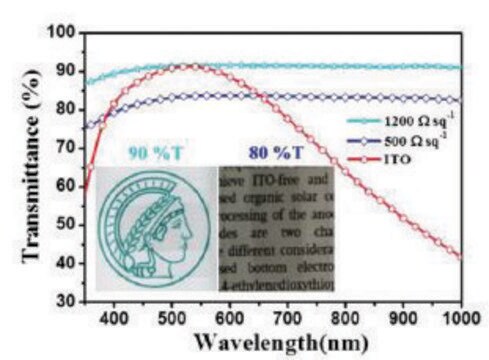932647
n-Type BBL:PEI ink
butanol-based
Synonym(s):
Poly(benzimidazobenzophenanthroline) polyethylenimine butanol ink, n-ink-40-1-B
About This Item
Recommended Products
description
Thermal stability (1h in N2): Up to 350 °C
Quality Level
composition
butanol (solvent)
work function
4.22 eV, UPS analysis
conductivity
((in plane): Up to 5 S/cm)
((out of plane): Up to 0.1 S/cm)
λmax
350 nm±5 nm
600 nm±5 nm
Application
It is compatible with large scale deposition methods, such as spray-coating and inkjet. The BBL:PEI ink can be further diluted for casting thin films in various thickness. BBL:PEI thin films were fabricated by spray-casting in air, followed by annealing at 140 °C for 2 h inside a nitrogen-filled glovebox or under vacuum to produce conducting films. The BBL:PEI ink, when processed, forms a high electron conducting n-type film that can be implemented as conducting layer in solar cells, thermoelectric generators, light-emitting diodes, or logic applications:
- OPV – Charge extracting layer in Organic Solar Cells
- SuperCapacitors – Negatrode in Organic Supercapacitors
- OECT – Active material in Organic Electrochemical Transistors
- OLED – Charge injecting layer in Organic Light Emitting Diodes
Preparation Note
- Always store the ink in dark and at ambient temperature.
- Shake the bottle vigorously to ensure an optimal dispersion of the ink prior to processing (by using ultrasonic bath for instance; 100 to 300 W for 30 min).
- The ink is primarily designed to be spray-casted, with an air-gun or similar spraying methods.
- The films are stable in air up to 2 days before its thermal activation.
- Always proceed with the thermal activation of ink under inert environments (vacuum, N2, Ar, etc.) or if properly encapsulated with an air-stable compound.
- Thermally activated films of our ink films are not affected by chloroform, chlorobenzene, 1,8-diiodooctane, dimethylformamide and dimethyl sulfoxide.
Signal Word
Danger
Hazard Statements
Precautionary Statements
Hazard Classifications
Acute Tox. 4 Oral - Eye Dam. 1 - Flam. Liq. 3 - Skin Irrit. 2 - Skin Sens. 1 - STOT SE 3
Target Organs
Central nervous system, Respiratory system
Storage Class Code
3 - Flammable liquids
WGK
WGK 2
Flash Point(F)
95.0 °F
Flash Point(C)
35 °C
Regulatory Listings
Regulatory Listings are mainly provided for chemical products. Only limited information can be provided here for non-chemical products. No entry means none of the components are listed. It is the user’s obligation to ensure the safe and legal use of the product.
FSL
Group 4: Flammable liquids
Type 2 petroleums
Hazardous rank III
Water insoluble liquid
ISHL Indicated Name
Substances Subject to be Indicated Names
ISHL Notified Names
Substances Subject to be Notified Names
JAN Code
932647-10ML:
932647-BULK:
932647-VAR:
Choose from one of the most recent versions:
Certificates of Analysis (COA)
It looks like we've run into a problem, but you can still download Certificates of Analysis from our Documents section.
If you need assistance, please contact Customer Support.
Already Own This Product?
Find documentation for the products that you have recently purchased in the Document Library.
Our team of scientists has experience in all areas of research including Life Science, Material Science, Chemical Synthesis, Chromatography, Analytical and many others.
Contact Technical Service






![[6,6]-Phenyl C61 butyric acid methyl ester ≥99%](/deepweb/assets/sigmaaldrich/product/structures/359/221/d990c746-0960-4c69-bf76-fe09b193824d/640/d990c746-0960-4c69-bf76-fe09b193824d.png)




